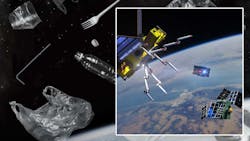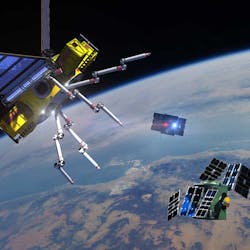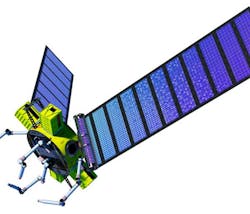Rogue Space Systems Corp. is on a mission to make a clean sweep of collecting debris in low-Earth orbit.
The New Hampshire-based company is in the process of developing orbital robots (dubbed orbots) that will allow for the safe removal of space debris. Its main robot, Fred, is designed to move satellites and other assets to and from different orbits.
“With the acceleration of commercial space, one interesting fact is that in the year 2021 there was more mass sent to space in one year than all the previous 70 years of space exploration combined,” said Jeromy Grimmett, founder and CEO of Rogue Space Systems Corporation.
He estimates that we’ve catalogued between 23,000 to 25,000 known objects. However, there are hundreds of thousands of objects that we can’t see. “Nuts, bolts, astronaut gloves, Tic Tac cases…I mean there’s all kinds of stuff that’s floating around in space because of human presence.”
Grimmett described how omnimagnets—in development through a partnership with the University of Utah—can be used to stop objects from tumbling to Earth. The technology will allow controllers to manipulate even non-magnetic objects in space and allow for six degrees of movement, he explained. Omnimagnet technology, which consists of electromagnets, create a magnetic field and synchronizes the orbit with the targeted piece of debris.
But Rogue Space Systems has a long-term vision that encompasses much more than clearing space debris. Building tools to address the space junk problem is part of a strategic move as the company engages with the growing global space market. One goal, said Grimmett, is to become an interplanetary services company that encompasses everything from transport to communications transactions.
The company seized on the opportunity to apply for state funding for space innovation and services in 2021, after General David D. Thompson, vice chief of Space Operations for the United States Space Force, stated that funding was available for commercial companies that can offer solutions to dealing with space debris mitigation.
Since 2010, the official policy in the U.S. has made clear the need to preserve the space environment and minimize the creation of human-made debris.
“We want to be the infrastructure that supports and enables the space economy,” Grimmett said. “It’s not going to happen overnight, but we’re going to get there. As commercial business and U.S. national interest increase in space between the Moon and Mars, Rogue is going to be there.”
In the following edited version of a three-part video interview with Machine Design, Grimmett outlined why he believes space junk has become a “national security imperative” that should be dealt with.
Machine Design: Jeromy, you’re navigating a subset of the space industry that remains largely untapped. But you’re changing all of that. Tell us about your work and the solutions that you provide.
Jeromy Grimmett: We are building orbital robots to go and deal with space debris—primarily satellite servicing. When we first started Rogue, we had built the company around the idea of dealing with space debris and space junk. But what we quickly found out was that there was no market for it. No one was paying to solve that problem until late 2020, early 2021, when the vice chief of Space Operations, United States Space Force, General Thompson, stated that he would pay commercial companies to deal with space debris.
Now, this is a pretty big pivot from what was the norm over the course of the past several years, and through that we then re-pivoted. So, we started off with space junk; we pivoted to satellite servicing, which is analog to space junk or capturing and repairing satellites, refueling, power augmentation and things of that nature. We kind of re-pivoted back to space debris, so we never really stopped working on space debris. It just got brought to the forefront through the Space Force’s request to industry that we try and get in there and start helping to solve that problem.
MD: For those who are less familiar with what is going on in the Earth’s orbit, bring us into that space.
JG: If you go to https://sky.rogue.space you’ll see what it looks like in orbit around the Earth, and all the different objects that are out there…So there are all these things that we do know about and then there are all these other things that we don’t know about, because our radar is not good enough and our ground-based measurement systems are not good enough to detect that stuff. We aggregate data from multiple sources in order to try and create the clear picture of what is out there.
MD: We’re seeing this onslaught of commercial space traffic—I’m reading a lot more about it. How will more space activity exacerbate the problem?
JG: Congress is trying to do things to improve the situation and, in this particular case, some government regulation would probably go a long way. Currently, the de-orbit lifetime is 25 years. So, as long as you can get your stuff out of orbit within 25 years, you’re pretty much okay. Nobody’s really going to say much of anything. However, there’s no enforcement mechanism, there are no fines, there’s nothing out there to force a company to remove that satellite. They just leave this stuff up there because there’s not really a penalty, and it costs so much to get it down.
I’m pretty excited to see what the Administration and Congress do regarding space debris; they’re trying to take some action. In my opinion, it’s a national security imperative that we deal with. Because, with the acceleration of commercial space, one interesting fact is that in the year 2021 there was more mass sent to space in one year than all the previous 70 years of space exploration combined. That is a dangerous place to be.
Now we have Starship [a fully-reusable, super-heavy-lift launch vehicle under development by aerospace manufacturer SpaceX]. It’s coming up, and guess what? That means tens of thousands of metric tons worth of cargo that they can payload, that they can deliver into space. SpaceX is on pace to launch, I think, 50 to 55 rockets this year. They are trending hard and they’re putting more and more mass in space. It stands to reason that we will outpace 2021 pretty heavily. And then, with Starship coming into service, it’s only going to get worse.
MD: Tell us about the orbot program. Who is Fred? What is an orbot, and what are its capabilities?
JG: An orbital robot is effectively a satellite that can go out autonomously and deal with the problem.
Now, right out of the gate, they’re not going to be fully autonomous. However, that is the goal—to develop spacecraft that are fully autonomous, that can go and deal with space debris. It can go and attach something to increase the drag on a spacecraft that is decrepit, it can de-orbit it faster, it can go and inspect an object in space so that we can find out what’s going on and what’s wrong.
There’s a series of orbots. The first one is called Barry; he’s a very small little robot that is used to test and demonstrate some technology. Then you have Laura, who’s an inspection and observation satellite spacecraft. Then you have Charlie, a robotic-enabled spacecraft, a little bit larger, about 150-200 kilograms.
And then, Fred, the one that you asked about, is a pretty sizable spacecraft at 325 kilograms. It has four robot arms. It kind of looks like a hornet whenever it’s fully deployed. It’s pretty cool-looking. And it’s got an array of highly sophisticated sensors that we use to do a lot of detection and understand the environment that’s around it.
MD: What will be Fred’s objective once it is in orbit?
JM: It will be able to transport the smaller orbots around the Earth and move them to locations where they might be needed to do inspections and observations or post them around something. Fred can also grab a hold of something, it can attach to something and move it, it can attach other things to another object, it has the ability to detumble an object in space.
Things in space are not static; they’re not just sitting there. Given the Earth’s influence and gravity and solar winds, they actually start spinning and moving in the various axes. That being said, you have to be able to de-tumble that stuff, and that’s why we are exploring the omnimagnet technology with the University of Utah.
Fred’s purpose, basically, is to be the tow truck, the forklift, the mobile repair shop, because you can even change out tools at the end of those robot arms, depending upon the circumstances that you find yourself in.
We’re aggressively going after Fred, by trying to put that in space by the end of 2023, early 2024. It’s a very aggressive timeline, but hey, it’ll be a fun goal to see if we can pull it off.
MD: Can you talk a bit about the AI-enabled sensory observation technology platform?
JG: In order to understand what’s going on, you have to aggregate all of the sensors and all of the sensor inputs that the spacecraft is using. Everything from radar, to LiDAR, to range finding, to all the cameras. All of it has to get aggregated in order to clearly form a contextual picture of what’s around it, what’s moving, what’s not moving and where it is in relation to the target. It’s a highly complex problem that has to be solved.
Orbot servicing requires the aggregation of that. In order to formulate decisions to conduct a safe operation in space, we don’t always have real-time access to the spacecraft. If there’s something that starts going wrong, the orbot needs to be able to say, “Hang on a minute, this is wrong. I need to back off.” And then it can just disengage from that object.
MD: Can you elaborate on the omnimagnet concept and how the technology works?
JG: It’s some real Star Trek stuff. You may know this, but every metal is affected by magnetic waves. Some more than others. Iron, for example, that’s really on the end of the spectrum, has a strong influence. Aluminum and copper, not so much, but there’s still an effect. Omnimagnets project out magnetic fields and the Eddy currents that are generated through those magnetic fields pass through the metal within an object and can actually influence it over time.
And so, one of the dirty secrets of space debris and space debris removal that nobody wants to talk about—except for Rogue—is: How do you detumble an object without breaking it? If I fly up to a spacecraft, or I fly up to an object in space, and it’s rotating and spinning around, I have to bring my orbot up to it, and then I try and maneuver and match all the spin so that I can safely approach and grab a hold of it. Well, that is very expensive from a fuel standpoint and it’s almost impossible to do.
I can shoot it with a harpoon and then the mass of this object and the speed at which it’s moving will just grab my orbot. I can twirl it around and then we have a disaster. If I shoot it with a net, I still have the same problem, except now I’ve probably broken off a few extra pieces and I’m getting dragged along with it.
Magnetic Eddy currents and omnimagnets solve that problem because we don’t have to touch the object. We can stand off, we can project the magnetic fields, and over time, we can slow the spin in those six axes, so that we can safely approach, grab a hold of it, attach drag lines and attach drag streams to it, and then allow it to decay naturally into the upper atmosphere. That is a safe, sustainable, non-debris creating way of solving a problem.
Rogue happens to be in partnership with the University of Utah to do that. It’s already demonstrated in the lab. It does work. It’s real. It’s not science fiction, it’s science fact. It’s a beautiful, brilliant combination of physics and AI/machine learning and robotics. It’s just really an elegant solution.
View part 1: Satellite Trash Collectors: Policies for Space Debris
View part 2: Orbots: Out of Sci-Fi and into Action
View part 3: Next Frontier: Space Disposal Systems and Satellite Servicing
About the Author

Rehana Begg
Editor-in-Chief, Machine Design
As Machine Design’s content lead, Rehana Begg is tasked with elevating the voice of the design and multi-disciplinary engineer in the face of digital transformation and engineering innovation. Begg has more than 24 years of editorial experience and has spent the past decade in the trenches of industrial manufacturing, focusing on new technologies, manufacturing innovation and business. Her B2B career has taken her from corporate boardrooms to plant floors and underground mining stopes, covering everything from automation & IIoT, robotics, mechanical design and additive manufacturing to plant operations, maintenance, reliability and continuous improvement. Begg holds an MBA, a Master of Journalism degree, and a BA (Hons.) in Political Science. She is committed to lifelong learning and feeds her passion for innovation in publishing, transparent science and clear communication by attending relevant conferences and seminars/workshops.
Follow Rehana Begg via the following social media handles:
X: @rehanabegg
LinkedIn: @rehanabegg and @MachineDesign



